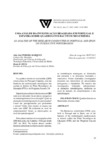Uma análise da investigaçâo realizada em Portugal e Espanha sobre quadros interactivos multimédia

View/
Use this link to cite
http://hdl.handle.net/2183/12121Collections
Metadata
Show full item recordTitle
Uma análise da investigaçâo realizada em Portugal e Espanha sobre quadros interactivos multimédiaAlternative Title(s)
An analysis of the research conducted in portugal and spain on interactive whiteboardsDate
2012Citation
Revista Galego-Portuguesa de Psicoloxía e Educación, 2012, 20: 39-48. ISSN: 1138-1663
Abstract
[Resumo] Os quadros interativos multimédia (QIM) constituíram, em Portugal e Espanha, uma das bandeiras da modernização tecnológicas das escolas no âmbito do Plano Tecnológico da Educação (PTE) e do Programa Escuela 2.0. Importa pois conhecer a forma como os QIM estão a ser utilizados. Quais são as vantagens e os constrangimentos à sua utilização? Quais as alterações metodológicas por eles provocadas? Como são percepcionadas por professores e alunos? Estão mais atentos os alunos nas aulas com QIM? Há melhorias ao nível do comportamento? Quais as repercussões ao nível das aprendizagens? Procurámos analisar as investigações sobre QIM realizadas em Espanha e Portugal desde 2007 até 2010. Na análise desses estudos tentámos identificar os objectivos dos mesmos, as metodologias empregues, as dimensões das amostras e os principais resultados e conclusões. Foram analisadas investigações presentes nos repositórios de universidades portuguesas e espanholas. Na maioria das investigações realizadas percepcionamse alterações metodológicas, melhorias ao nível da atenção, do comportamento e das aprendizagens. [Abstract] The Interactive whiteboards (IWB) were, both in Portugal and in Spain, one of the banners of the technological modernization in schools within the Plano Tecnológico da Educação (PTE) and the Programa Escuela 2.0. Therefore it is important to know the way IWB are being used. What are the advantages and constraints to their use? Which methodological changes have they caused? How are they perceived by both teachers and students? Are students more attentive in classes where IWB is used? Are there improvements in terms of behavior? What is their impact on the learning level? We have sought to analyse the outcome of researches on IWB carried out in Spain and in Portugal from 2007 to 2010. By analysing these studies we have tried to identify their goals, the methods applied, the samples’ dimensions and their main results and conclusions. We have analyzed investigations kept in repositories in Portuguese and Spanish universities. In most investigations we were able to perceive changes in methods and improvements on the concentration, behavior and learning levels.
Keywords
Quadros interactivos multimédia
Interatividade
Interactive whiteboards
Interactivity
Interatividade
Interactive whiteboards
Interactivity
ISSN
1138-1663





